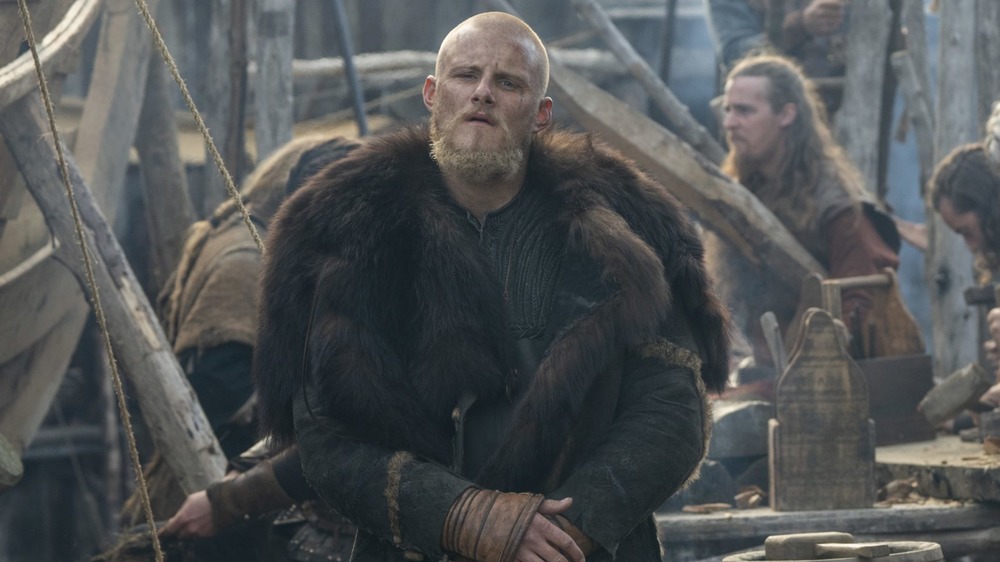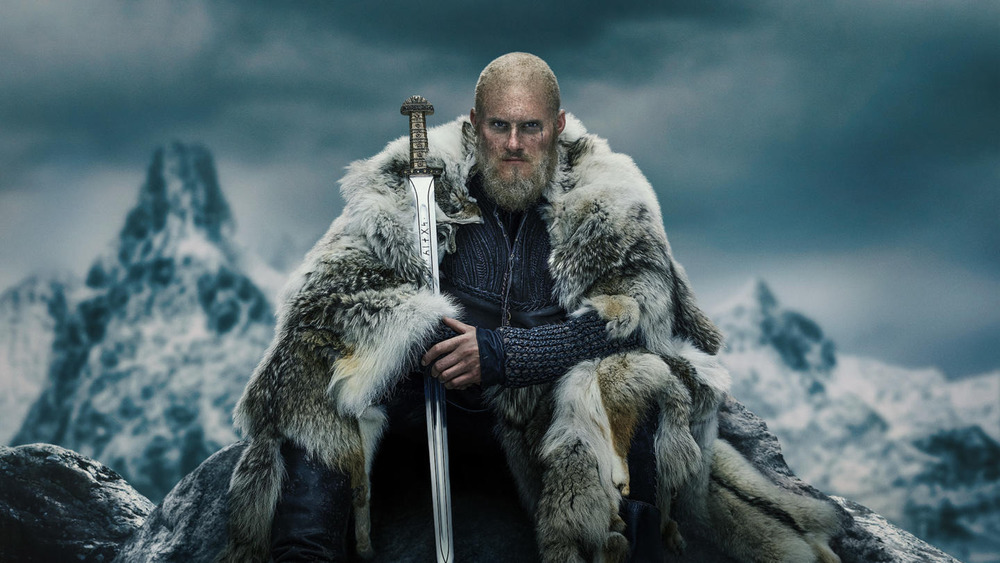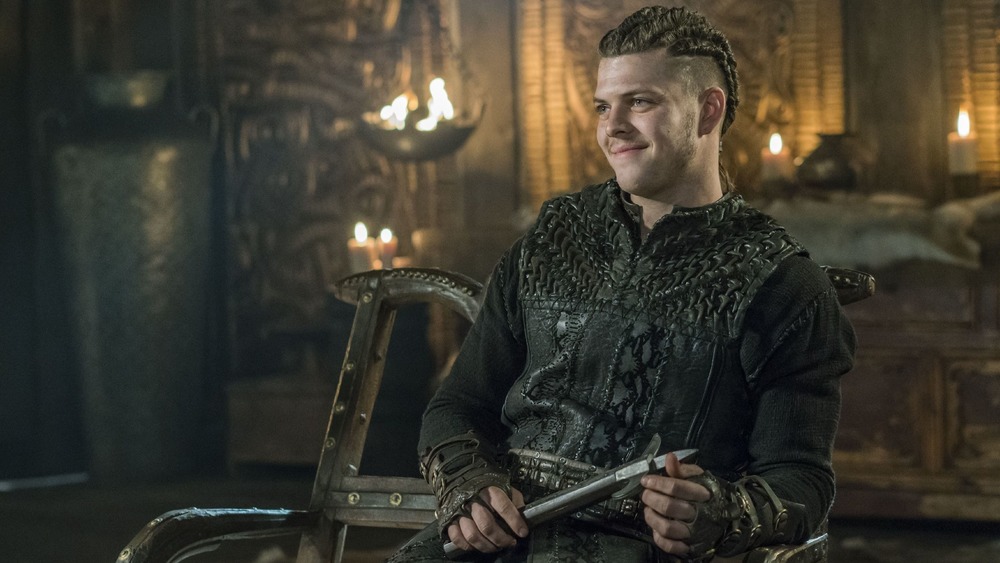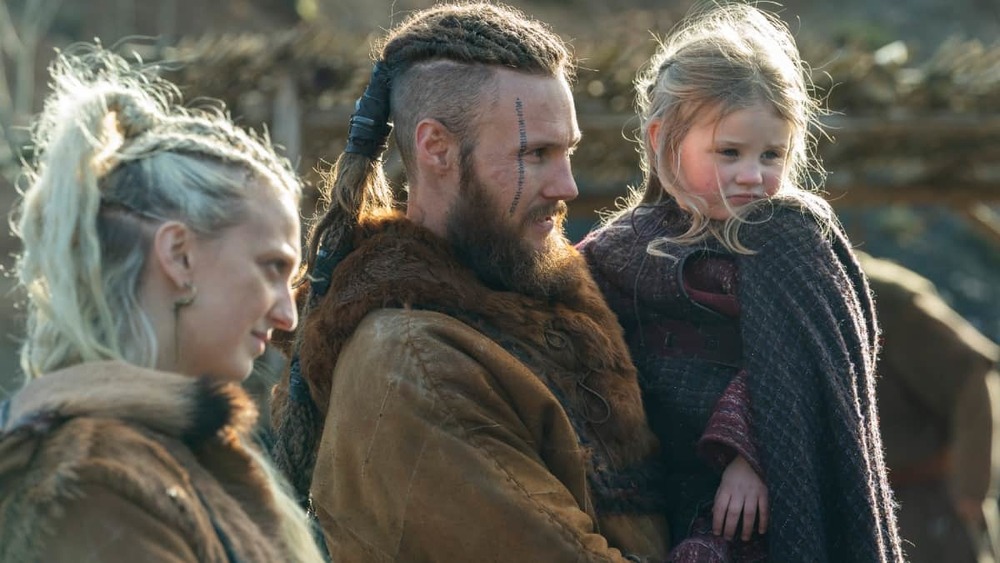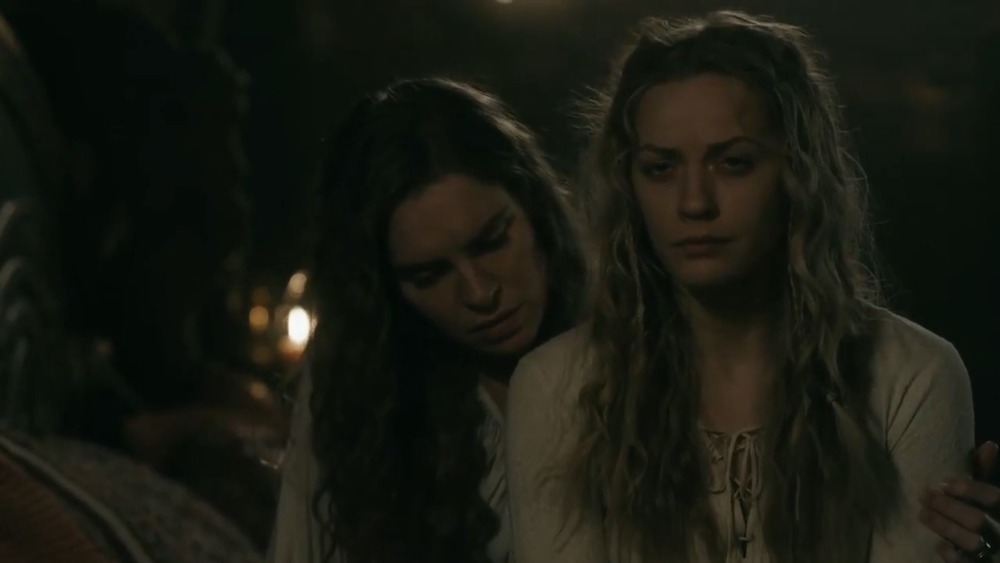What Really Happened To The Real Life Versions Of These Vikings Characters
Even though it first aired on History, a channel whose name couldn't be more self-explanatory, the violent drama Vikings presents a take on the rise of the Medieval Norse warriors which includes more than a few details that were invented by its writers. That is actually fitting, as one of the main sources for the series — namely, the sagas depicting the stories of Ragnar Lothbrok and his offspring — are themselves considered to be stories based on historic accounts that likely meld fact and legend (via Ancient History Encyclopedia).
The series just ended its run with its final 10 episodes premiering on Amazon Prime Video on December 30. Season 6B not only brought the series to its bloody (and heartfelt) conclusion, it also revealed the ultimate fate of most of the characters that rose to prominence over the last few seasons. But how many of the endings we saw on screen match with the character's counterparts from history and legend?
While the murky provenance of many of the details make it hard to determine exactly what happened to the people who inspired the legends that inspired the characters on Vikings, for the most part, we do know enough to see whether the show's writers stuck to the sagas, or wrote their own history.
The circumstances of the actual Bjorn Ironside's later life have been lost to history
After a season 6A cliffhanger that saw Bjorn Ironside (Alexander Ludwig) mortally wounded in his battle against the Rus, the character made a brief, but triumphant, recovery in the premiere episode of season 6B. He rode into battle one last time, which scared and confused his enemies, who had been convinced of his death. The gambit is enough to help ensure his army is ultimately victorious, but his wounds are too serious to recover from, and Bjorn eventually dies.
As for the real Bjorn Ironside, determining his ultimate fate is less cut and dry. According to Ancient History Encyclopedia, the figure known to legend as Bjorn Ironside was likely created from the actual history of a real person, or is even a composite figure based on the exploits of several people. He appears in various sagas concerning the exploits of Ragnar Lothbrok, and like the rest of the people from those works, the stories concerning him are likely mythologized to some degree. Either way, in most accounts of his legend, he isn't mentioned after he and his brothers torture and kill King Ælle of Northumbria as revenge for the King's murder of their father, Ragnar. What happened to him afterward is a mystery.
The blood eagling of King Ælle (Ivan Kaye) is depicted in season 4 of Vikings, so it's safe to say that, as far as major narrative beats go, everything involving Bjorn after that — including his heroic last stand against the Rus — was invented for the show.
Ivar the Boneless is said to have died an old man, not on the battlefield
Similar to his brother Bjorn, the actual historicity of Ivar is cloudy. The show portrays him as being a brilliant, but cruel, leader of his troops, and as living with Osteogenesis Imperfecta, aka brittle bone disease. Exactly why Ivar earned the title "Boneless" isn't known, other than that he appears to have lived with a disability that prevented the use of his legs, as he's described as being carried into battle, according to Ancient History Encyclopedia.
In the finale of Vikings, we see Ivar (Alex Høgh Andersen) seeming to encourage his own death on the battlefield fighting against King Alfred of Wessex (Ferdia Walsh-Peelo). It's a dramatic (and for some fans, confusing and unsatisfying) end to a bold character. It's also one that is significantly more climactic than how his story concludes in The Tale of Ragnar's Sons. In Peter Tunstall's translation of the Medieval text, Ivar's end is described simply as, "Ivar the Boneless was king in England for a long time [...] And he died of old-age in England and was buried there."
Ancient History Encyclopedia notes that other sagas have different versions of where he ended up at the end of his life, but none include him being shanked on the battlefield, the way that Vikings depicts.
It's unlikely the real Ubbe ever made it to the Golden Land
Vikings portrays most of Ragnar's sons as opting into the family business of raiding England, and the rest of Europe, until their dying breath. That is, except for Ubbe (Jordan Patrick Smith). While in early seasons he joins his brothers in leading their Great Heathen Army, the final season sees him on a much different journey. He travels first to Iceland to help settle the recently discovered land, and then even further, to an unnamed Golden Land, which today we call the eastern coast of Canada. Once there, Ubbe seems to begin a journey of leaving his old ways behind and embracing a new life. The last we see of him on the show, he's sitting on the shores of his new home, gazing out at the sea.
Historically, there are a lot of question marks surrounding the figure of Ubbe (or Ubba, as he's often referenced). While some sources name him as a brother of Ivar who helped him lead the Great Heathen Army, he's not referenced as such in all of the sagas concerning Ragnar and his sons (via Ancient History Encyclopedia). It is theoretically possible that whoever the figure Ubbe was based on traveled to Iceland, there's no historical evidence of him doing so.
It's also very unlikely that he made it all the way to the Americas, as the show depicts. The first known European to do so, Leif Erickson, didn't arrive until sometime in the early 11th century, well over a hundred years after the time of Ubbe and the gang.
The real truth of Bjorn Ironside's wives
Bjorn Ironside's death after his valiant effort against the Rus made widows of both of his wives, Gunnhild (Ragga Ragnars) and Ingrid (Lucy Martin). After her husband's death, Gunnhild decided that she'd seen enough in this world, and drowned herself in an effort to reunite with Bjorn in Valhalla. Ingrid, on the other hand, stuck around and found herself ruling as the Queen of Kattegat after remarrying King Harald (Peter Franzén).
Considering she began life as a slave, Ingrid's rise to power is an extraordinary story, as is Gunnhild's dramatic exit from this mortal coil. While the Viking sagas include many tales of legendary women who stood toe-to-toe with their male counterparts, both Gunnhild and Ingrid are entirely fictional characters. One thing that the Viking sagas do not include, according to Ancient History Encyclopedia, is any mention of Bjorn Ironside having a wife, let alone two.
When looking through the historic and legendary records that inspired the series Vikings, it's clear that, especially in its final season, the show opted to create its own conclusions for many of its characters. Perhaps in 1,000 years they will be incorporated into humankind's imagining of the Medieval Norse, the same way the sagas that inspired the show are included in ours.
